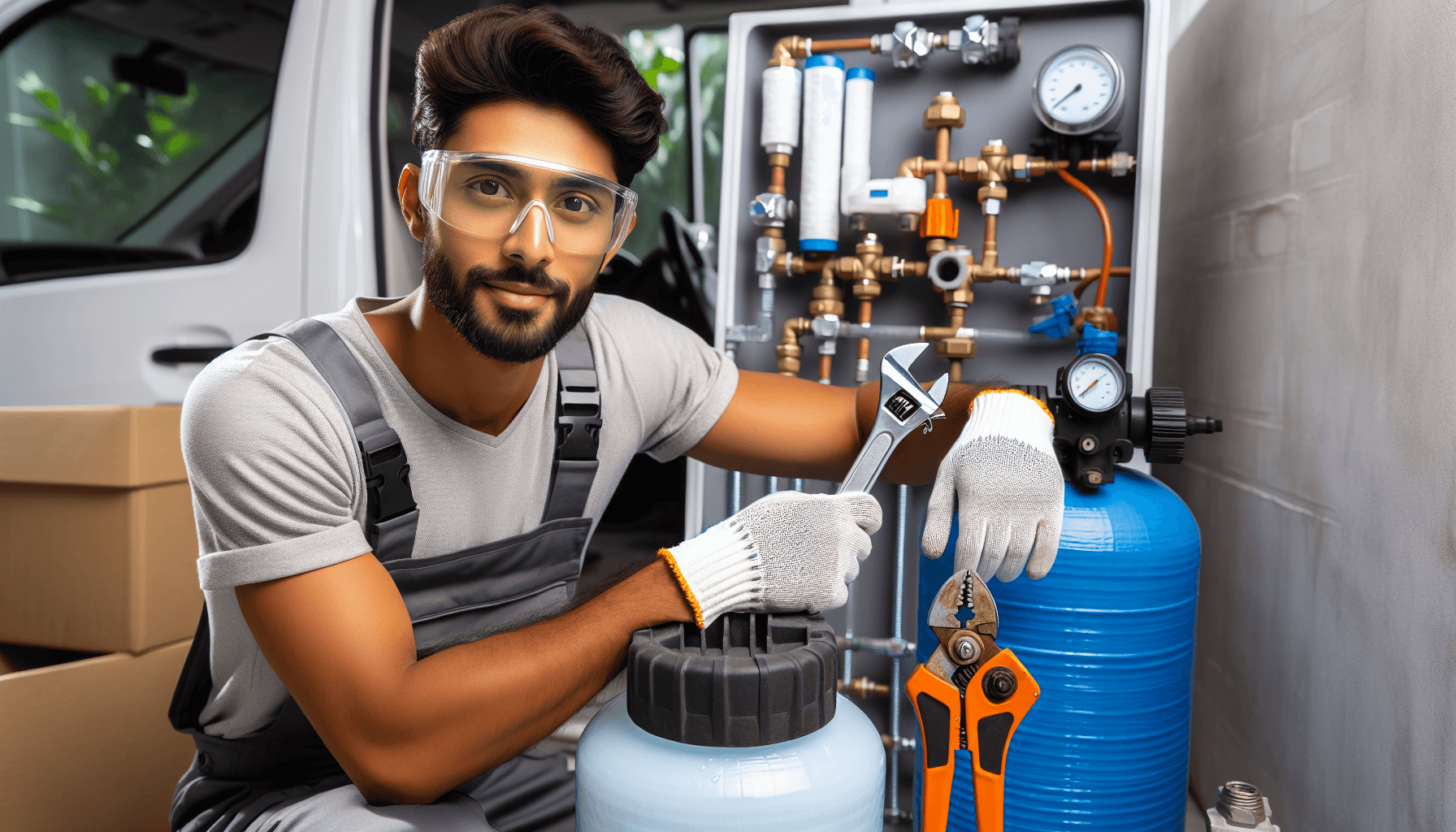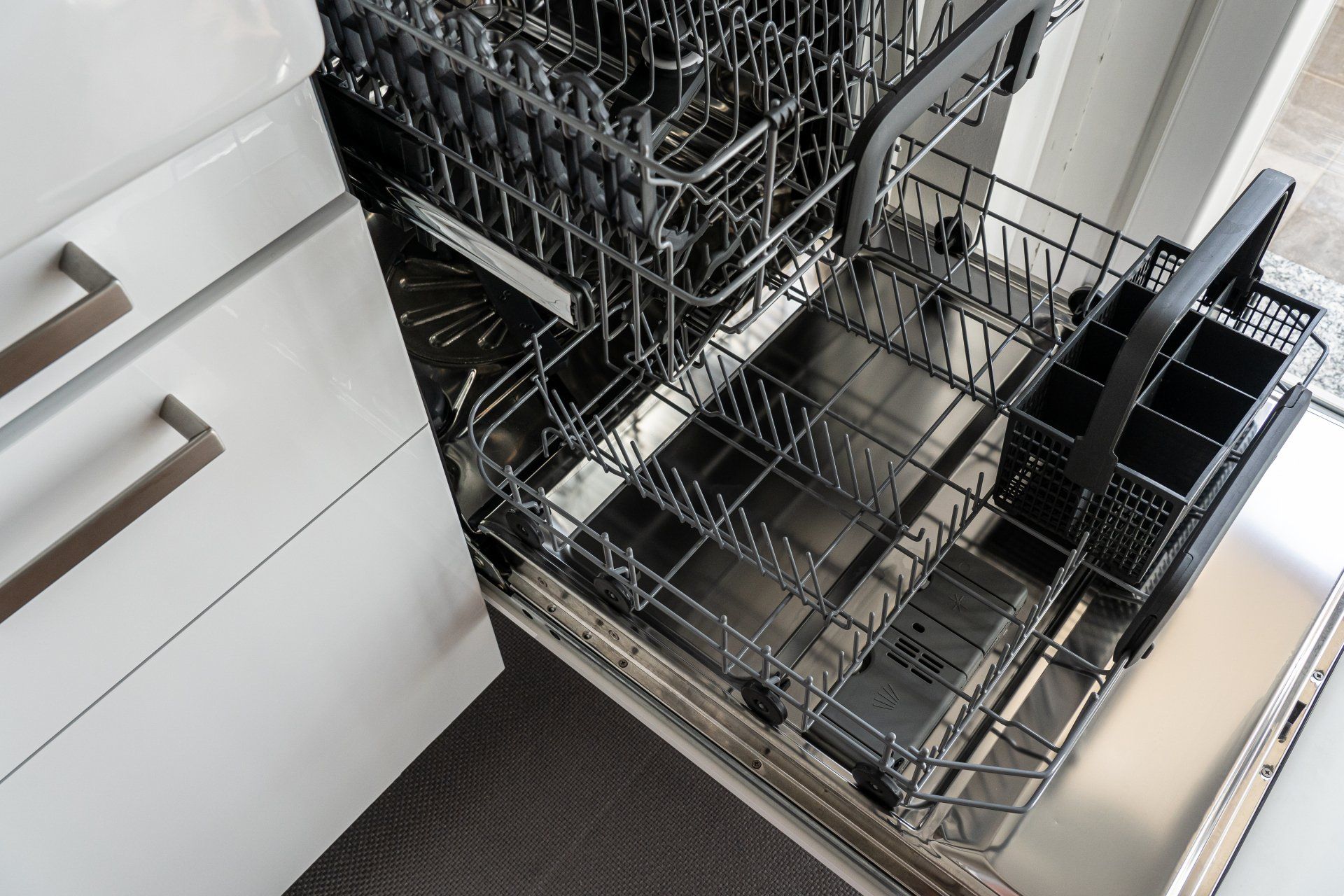Follow Us
Join our newsletter
Introduction to Water Softeners
SOFT WATER FEELS

A water softener is a whole-house filtration system that removes minerals like calcium and magnesium from hard water. The softener contains resin beads that attract and bind to the hard mineral ions as water passes through. This process replaces the hard minerals with softer sodium ions, transforming the water into "soft water".
Water softeners work through a process called ion exchange. As hard water flows into the mineral tank, it contacts the resin beads. The beads have a stronger attraction to the calcium and magnesium ions than sodium, so they latch onto the hard minerals and pull them from the water. Sodium ions are released from the beads to take the place of the hard mineral ions. This ion exchange process effectively softens the water by lowering the concentration of calcium and magnesium.
Installing a water softener provides numerous benefits:
- Soft water feels smoother on skin and hair, leaving you feeling refreshed after bathing. Hard water can leave behind dry, itchy skin.
- Soft water prevents scale buildup on fixtures and appliances. Hard water creates limescale deposits that reduce efficiency.
- Dishes and laundry come out cleaner with fewer spots. Soap suds up better in soft water.
- Appliances like water heaters and pipes last longer without scale accumulation. Maintenance costs are reduced.
- Using less detergent and soap since soft water rinses cleaner. Clothes and hair retain color vibrancy longer.
- Improves the taste of water for drinking and cooking. Hard water has a mineral taste.
Overall, a water softener improves the quality of water throughout the home, making cleaning easier while saving money on appliances, fixtures, detergents, and personal care products. The benefits of soft water make water softener installation a worthwhile investment for many homeowners.
Determining if You Need a Water Softener
Many homeowners wonder if they actually need a water softener system or if it's an unnecessary expense. There are a few key factors to consider when deciding if a water softener is right for your home.
The first step is to test your water's hardness level. Water hardness refers to the amount of dissolved calcium and magnesium in the water, which are metallic minerals that can cause scale buildup in pipes and appliances. You can use water hardness test strips or have your municipal water company provide a report on hardness levels, measured in grains per gallon (gpg).
Generally, water with a hardness level above 7 gpg is considered hard, and levels above 10-12 gpg are very hard. The harder your water, the more likely you'll experience issues like mineral deposits, soap scum, dry skin and hair, stained fixtures, and reduced efficiency of water-based appliances. If your home has hard water, a softener can help mitigate these problems.
Aside from testing, there are some common signs that your water supply is hard and a softener is needed:
- White/chalky mineral deposits on sinks and bathtubs
- Scale buildup in pipes, restricting water flow
- Soap scum on skin and surfaces after washing
- Dry, brittle hair even after conditioning
- Stiff laundry and discolored clothing
- Mineral spots on dishes even after drying
If you are experiencing any of these symptoms of hard water, installing a water softener can help restore your home's water quality and make daily tasks like cleaning easier. Even if your water hardness level falls in the moderate range, the benefits of softened water and reduced scaling may make a water softener system worthwhile.
Choosing the Right Water Softener System
When selecting a water softener, you'll need to decide between salt-based and salt-free models. Salt-based softeners remove hardness minerals by exchanging them for sodium or potassium ions. They tend to be more effective but require regular additions of salt. Salt-free softeners use template assisted crystallization to prevent scale build-up but don't reduce existing hardness.
The size and capacity of your softener depends on factors like household size, water usage, and hardness levels. Look for a system that can handle at least 2-3 days worth of water for a family of four. Under-sized units lead to hard water breakthrough.
Popular salt-based brands include Fleck, Whirlpool, GE, and Culligan. Look for a reputable brand with positive reviews and at least a 5-year warranty on the tank and control valve. Avoid models with excessive plumbing connections that may leak over time.
For salt-free systems, NuvoH2O and Kinetico K5 are top choices praised for their eco-friendliness and installation flexibility. However, salt-free softeners may need frequent filter replacements and are better suited for mildly hard water.
When comparing brands, pay attention to the warranty coverage, certifications, customer service reputation, and durability of parts. Your installer can also provide recommendations based on local water conditions and your household needs. Investing in a quality system will pay off in the long run.
Water Softener Installation Costs
Installing a water softener can be a significant investment, with costs ranging widely depending on the type of system, installation method, and features. Professional installation typically costs $1,500-$2,500 on average. DIY installation can reduce costs substantially, with materials running $500-$1,500 depending on the system. However, costs vary based on several key factors:
- **Size of Home and Water Usage:** The larger the home and higher the water usage, the larger capacity softener required, increasing costs. A standard 48,000 grain softener suitable for 2-3 bathrooms costs less than an 80,000+ grain one for larger homes.
- **Type of Softener:** More advanced digital or "smart" softener systems cost more than standard mechanical softeners. Salt-free softeners also run higher than salt-based ones.
- **Features and Settings:** Softeners with added features like WiFi monitoring, advanced programming, and filtration run higher in price. The overall softening capacity required also impacts cost.
- **Professional vs DIY Install:** Hiring a plumber for installation and programming typically adds $200-$600+ to the overall cost, compared to DIY. However, DIY requires ability and time.
- **Plumbing Modifications:** If substantial plumbing modifications are needed, this can drive up installation costs significantly. Minor modifications are usually cheaper.
- **Rebates and Incentives:** Many municipalities offer rebates up to $200-$500 for water softener installation to reduce hardness and scale in water systems. Checking for local rebates can offset some costs.
Consider both short and long-term costs when choosing a water softener. While DIY installs have lower upfront costs, improper installation can lead to higher repair and replacement costs later on. Professional installs often come with warranties and guarantees, providing more long-term value. Performing a break-even analysis based on your DIY abilities, time, and long-term costs can help determine the best value.
Location Selection
Choose a location with these factors in mind:
- Near the main water supply line - Install the softener close to where the main water pipe enters your home. This minimizes long pipe runs.
- Accessible space - Leave room to access the softener for servicing and maintenance.
- Protected from elements - Don't install in an area exposed to freezing temperatures or direct sunlight. A basement or utility room is ideal.
- Drainage - There must be a suitable drain nearby for the periodic backwash cycle. A floor drain is preferred.
- Electrical outlet - The softener will require a nearby 120V electrical outlet.
Measure the space to ensure your softener model will fit properly.
Plumbing Requirements
Some key plumbing steps for installing a water softener:
- Shut off main water supply and drain pipes.
- Cut into the main water supply line at the planned installation point.
- Install inlet and outlet shutoff valves on the main supply line.
- Attach flexible stainless steel hoses to connect the softener to the main supply line shutoff valves.
- Run a drain line from the softener drain port to the nearby drain.
Use the correct fittings and follow all local plumbing codes. Avoid soldering pipes with lead. Thoroughly flush pipes before reconnecting main supply.
Hiring a Professional for Water Softener Installation
Hiring a professional to install your water softener has several key benefits compared to doing it yourself:
Expert Knowledge and Experience
Professional installers have extensive training and experience specifically with water softener systems. They know all the ins and outs of proper installation, including optimizing the location, sizing, plumbing requirements, programming, and start-up. Their expertise can ensure your system operates efficiently right from the start.
Correct Sizing and Configuration
The installer will assess your home's water conditions, household size, and usage to determine the correctly sized softener. They can also advise on the best system configuration for your needs. Improper sizing or setup of a DIY installation can lead to insufficient softening capacity or wasted salt and water.
Warranty Support
Many manufacturers require professional installation to maintain the product warranty. DIY installs often void the warranty, leaving you without coverage should issues arise. Qualified installers provide warranty support.
Peace of Mind
With a professional handling the complex installation process, you can relax knowing it's done right. You avoid the stresses and uncertainties of taking it on yourself as an amateur.
Questions to Ask Potential Installers
When selecting a professional installer, ask the following key questions:
- Are you certified by the manufacturer for this brand of softener?
- How long have you been installing water softeners?
- Do you handle all necessary plumbing modifications?
- What is your warranty on labor?
- Can you provide references from past clients?
Additional Costs to Consider
Beyond the base installation fee, hiring a pro may involve additional costs such as:
- Travel fees if located far from the installer's service area
- Charges for extensive plumbing modifications
- Permit fees
- Removal of old softener system if replacing an existing unit
Getting an itemized estimate beforehand helps avoid any surprises down the road.
Maintenance and Servicing
Proper maintenance is crucial to keep your water softener running efficiently and effectively. Here are some key maintenance tasks:
Sanitizing the Resin Bed
The resin bed inside your softener should be sanitized periodically to prevent bacteria growth and fouling. This involves adding sanitizer like bleach or vinegar to the brine tank and running a manual regeneration cycle. Consult your owner's manual for specific sanitizing instructions. Plan to sanitize the resin bed at least once a year.
Replenishing Salt
Check the salt level in your brine tank monthly. Refill with salt pellets when the level drops below halfway. Use only purified salt pellets; avoid rock, block, or granulated salt. Add the salt slowly to prevent bridging.
Changing Filters
If your softener has pre-filters, change them as recommended by the manufacturer, usually every 3-6 months. This removes sediment and prolongs the life of your resin bed. Replace any carbon post-filters annually.
Inspecting Parts
Examine all hoses, clamps, seals, and o-rings for wear or leaks during routine maintenance. Replace any deteriorated parts. Lubricate o-rings and seals to prevent drying.
Running Diagnostics
Many softeners have built-in diagnostics to monitor performance. Run these regularly per the user manual. Diagnostics can detect issues like low salt levels, excessive water usage, and programming errors.
Manual Regenerations
Occasionally run a manual regeneration cycle on your softener to fully recharge the resin and flush the system. This helps optimize efficiency.
Staying on top of maintenance keeps your water softener working properly for years to come. Consider signing up for an annual maintenance service contract with a professional if you want assistance.
Troubleshooting Issues
Once your water softener is installed, it should run smoothly for years. However, occasional issues can arise. Here are some common problems and how to fix them:
Low Water Pressure
If you notice a drop in water pressure after installing a water softener, there are a few possible causes:
- Clogged resin bed: Over time, sediment and minerals can restrict the flow of water through the resin bed. Clean the resin bed by running a regeneration cycle with water and resin bed cleaner.
- Plugged injector nozzle or venturi: Scale buildup may clog the injector nozzle or venturi, restricting the flow of brine. Carefully remove buildup with a thin wire.
- Blocked drain line flow control: Debris or sediment could be blocking the drain line flow control. Disconnect the control and gently flush it out.
- Improperly sized unit: If your water softener is too small for your household needs, it can struggle to keep up with demand, lowering water pressure. Consult a professional to determine if you need a larger system.
Salt Bridge
A salt bridge forms when a hard crust of salt forms in the brine tank. It prevents water from coming into contact with salt, stopping the regeneration process.
To break up a salt bridge:
- Carefully push a broom handle or similar object down into the salt to break up the bridge. Do not use anything sharp or metal that could puncture the brine tank.
- Add warm water to the tank and stir the salt. The warmth will help dissolve the salt bridge.
- Use salt designed to prevent bridging. Some salts contain an anti-bridging agent.
- Maintain proper salt levels. Keep the tank at least half full at all times.
Error Codes
Most water softeners will display an error code if something is not working properly. Check your owner's manual for specific error code meanings. Here are some common ones:
- E1 - No water flow. Check for closed valves or clogged filters.
- E2 - Regeneration failure. The unit failed to complete a regen cycle. May indicate electrical issue.
- E3 - Motor stalled. The control motor is having difficulty turning the valves.
- E4 - No salt in brine tank. Refill with salt right away.
- Err - Electronics failure. May require control board replacement.
Troubleshooting error codes can prevent more serious problems. Call the manufacturer if you cannot resolve it yourself.
Upgrading or Replacing Your Water Softener
Over time, your water softener system may start to show signs of wear and will need to be replaced. Here are some signs that it may be time to upgrade your unit:
- The system is 10 years or older. Most have a lifespan of 8-12 years.
- You notice a decrease in water pressure. Clogged resin beads can reduce flow.
- Your water's hardness is increasing. The softener can't keep up with demand.
- You have to add salt more frequently. Excess salt use signals inefficiency.
- The tank is leaking or corroded. Cracks and leaks mean the tank is failing.
- Regeneration cycles happen more than once per day. Frequent cycling indicates a problem.
- Your water smells like rotten eggs. Bacteria buildup causes sulfur odors.
When shopping for a new system, look for additional features like:
- Demand-initiated regeneration to maximize efficiency
- Backlit digital displays and user-friendly controls
- Built-in memory to retain settings during power loss
- Metered models to match usage and water hardness
- WiFi connectivity and mobile app integration
To remove an old unit, shut off the water lines and power, disconnect plumbing connections, detach the control valve head, and drain the brine tank. You may need to cut away the resin tank to fully extract it. Make sure to follow all local regulations when disposing of the old system.
Upgrading your outdated or failing softener is the best way to restore water quality and pressure in your home. A new efficient system will save salt, water, energy, and money over time.
Related Articles
Related Articles
STAY UP TO DATE
GET WATERLUX's LATEST
Receive updates from the company and get a heads up on upcoming sales and new products
Contact Us



